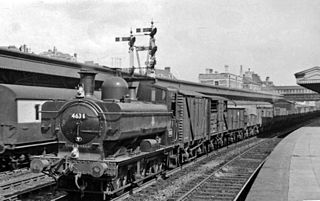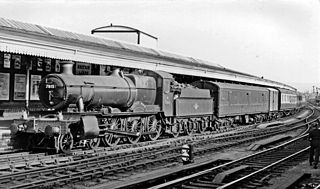
A tank locomotive or tank engine is a steam locomotive that carries its water in one or more on-board water tanks, instead of a more traditional tender. Most tank engines also have bunkers to hold fuel; in a tender-tank locomotive a tender holds some or all of the fuel, and may hold some water also.

Woodham Brothers Ltd is a trading business, based mainly around activities and premises located within Barry Docks, in Barry, South Wales. It is noted globally for its 1960s activity as a scrapyard, where 297 withdrawn British Railways steam locomotives were sent, from which 213 were rescued for the developing railway preservation movement.

The GWR 5700 Class, or 57xx class, is a class of 0-6-0 pannier tank steam locomotive built by the Great Western Railway (GWR) and British Railways (BR) between 1929 and 1950. With 863 built, they were the most prolific class of the GWR, and one of the most numerous classes of British steam locomotive.

The Great Western Railway (GWR) 7800 Class or Manor Class is a class of 4-6-0 steam locomotive. They were designed as a lighter version of the Grange Class, giving them a wider Route Availability. Like the 'Granges', the 'Manors' used parts from the GWR 4300 Class Moguls but just on the first batch of twenty. Twenty were built between 1938 and 1939, with British Railways adding a further 10 in 1950. They were named after Manors in the area covered by the Great Western Railway. Nine are preserved.

The Great Western Railway (GWR) 2251 Class or Collett Goods Class was a class of 0-6-0 steam tender locomotives designed for medium-powered freight. They were introduced in 1930 as a replacement for the earlier Dean Goods 0-6-0s and were built up to 1948.

The Great Western Railway (GWR) 1600 Class is a class of 0-6-0 pannier tank steam locomotive designed for light branch lines, short-distance freight transfers and shunting duties.

The Great Western Railway (GWR) 1366 Class is a class of 0-6-0 pannier tank steam locomotives built in 1934. They were a useful design and because of their light weight and short wheelbase and were often used on dockside branches or other lines with sharp curvatures.

A motive power depot (MPD) or locomotive depot, or traction maintenance depot (TMD), is where locomotives are usually housed, repaired and maintained when not being used. They were originally known as "running sheds", "engine sheds" or, for short, just sheds. Facilities are provided for refuelling and replenishing water, lubricating oil and grease and, for steam engines, disposal of the ash. There are often workshops for day to day repairs and maintenance, although locomotive building and major overhauls are usually carried out in locomotive works.

The Great Western Railway (GWR) 4700 Class was a class of nine 2-8-0 steam locomotives, designed by George Jackson Churchward. They were introduced in 1919 for heavy mixed-traffic work. Although primarily designed for fast freight, the class also sometimes hauled passenger trains, notably heavy holiday expresses in the summer months. They were called "Night Owls" because they were primarily designed to haul goods during the night and they could be seen simmering in the daylight, awaiting their nocturnal duties.

Birkenhead Mollington Street was a former traction maintenance depot located at Mollington Street in Birkenhead, England, on the Birkenhead Dock Branch railway. Although never directly connected by rail, the depot was situated less than 200 m (660 ft) from Birkenhead Central railway station. The depot serviced steam and subsequently diesel locomotives until 1985, when it was closed and demolished. As of 2018, the site of the depot is still disused.

Penzance TMD, also known as Long Rock TMD, is a railway traction maintenance depot situated in the village of Long Rock east of Penzance, Cornwall, England, and is the most westerly and southerly rail depot in the country. The depot operator is Great Western Railway. The depot code is PZ.

The GWR 2021 Class was a class of 140 0-6-0ST steam locomotives. They were built at the Wolverhampton railway works of the Great Western Railway between 1897 and 1905. 1897 was the very year of George Armstrong's retirement, so it is uncertain if the design should be attributed to him or to his superior at Swindon, William Dean.

The GWR Class 850 was an extensive class of small 0-6-0ST locomotives designed by George Armstrong and built at the Wolverhampton railway works of the Great Western Railway between 1874 and 1895. Aptly described as the GWR equivalent of the LB&SCR "Terrier" Class of William Stroudley, their wide availability and lively performance gave them long lives, and eventually they were replaced from 1949 by what were in essence very similar locomotives, the short-lived 1600 Class of Frederick Hawksworth, which in the headlong abandonment of steam outlived them by a mere seven years or so.
The 3206 or Barnum Class consisted of 20 locomotives built at Swindon Works for the Great Western Railway in 1889, and was William Dean's most successful 2-4-0 design. Numbered 3206–3225, they were the last GWR locos built at Swindon with "sandwich" frames.

Crosstown Linkline was a railway service that operated from 14 May 1979 to 11 May 1985 between Camden Road and North Woolwich in London, England. The service was operated by British Rail with financial support from the Greater London Council. It reintroduced passenger trains to sections of line that had not been served for over thirty years. It benefited from several improvements during its brief existence as new stations were added and trains started running on Saturdays in 1983. Operated by diesel trains, it was replaced with the electric North London Link service between Richmond and North Woolwich from 13 May 1985.
Croxley Green Light Maintenance Depot was a traction maintenance depot located in Croxley, Watford, England that provided storage and light maintenance for electric multiple units working the Watford DC line.

Healey Mills Marshalling Yard was a railway marshalling yard located in the village of Healey, south west of Ossett in West Yorkshire, England. The yard was opened in 1963 and replaced several smaller yards in the area. It was part of the British Transport Commission's Modernisation plan, and so was equipped with a hump to enable the efficient shunting and re-ordering of goods wagons. The yard lost its main reason for existence through the 1970s and 1980s when more trains on the British Rail system became block trains where their wagons required less, or more commonly, no shunting.

MS Europic Ferry was a roll-on/roll-off car ferry built in 1967 by Swan Hunter for the Atlantic Steam Navigation Company (ASN). She was acquired by European Ferries in 1971 when they took over the ASN and served with them under the Townsend Thoresen branding. The Europic Ferry was requisitioned by the British government in April 1982 and transported stores, equipment and troops to the South Atlantic during the Falklands War. After the war she returned to service with European Ferries until that company was sold to P&O in 1987. She was sold again to Namora Shipping in 1993 and served on routes in the Mediterranean until sold for scrapping in 2004.

Broomhill railway station served the village of Broomhill in Northumberland, England, a former pit village. The station was on a short branch line of about 5 miles (8 km) which linked the town of Amble with the East Coast Main Line near to Chevington.

Marine Court is a Grade II listed Streamline Moderne apartment block on the seafront of St Leonards-on-Sea, part of the town and borough of Hastings in East Sussex, England. The block was built between 1936 and 1938 and was modelled on the recently launched Cunard ocean liner Queen Mary. The building is 14 stories high and the seafront elevation 416 ft (127 m) long. At the time of opening it was the tallest residential building in Britain.
























